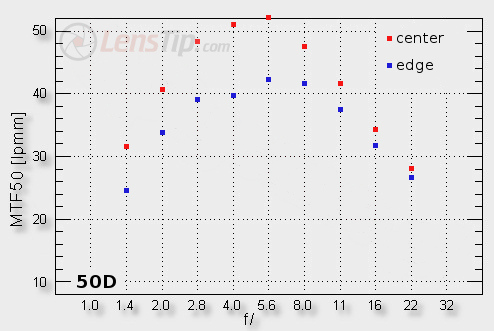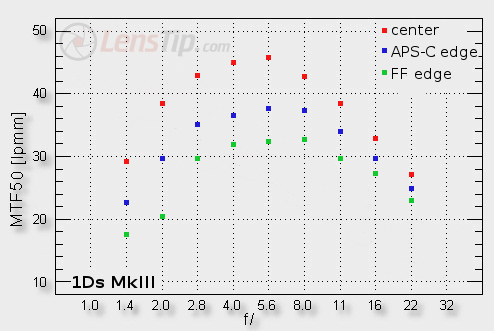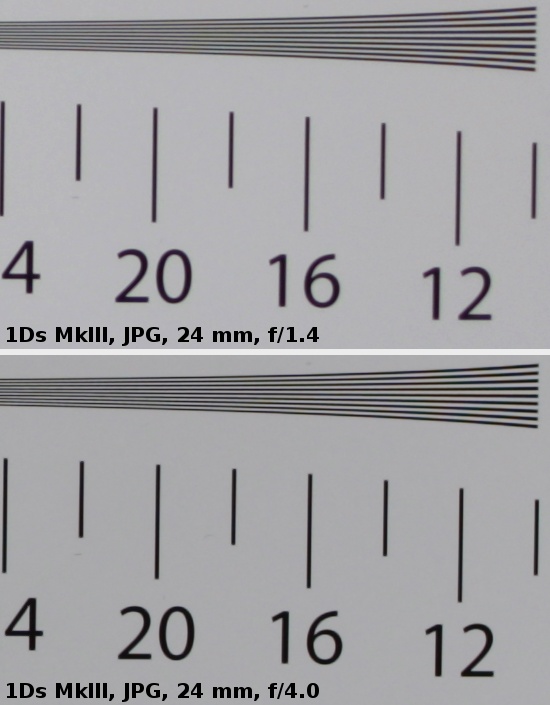Canon EF 24 mm f/1.4L II USM
4. Image resolution

In the frame centre the maximum relative aperture might constitute a problem for purists. On the 50D’s sensor, densely packed with pixels, the decency level is set near 34-35 lpmm. The instrument, tested here doesn’t go so far, reaching almost 32 lpmm. On just minimal stopping down, though, the decency level is achieved and we can enjoy fully sharp photos. However, it is worth noticing that not many lenses as fast as this one manage to reach these 34-35 lpmm so looking from that perspective the Canon 24L results in the frame centre are very good. Especially that the image quality improves very swiftly on stopping down. By f/2.0 the MTF50 function value exceeds 40 lpmm and by f/2.8 it is higher than 48 lpmm. The maximum results, exceeding 52 lpmm, are reached by f/5.6 – a truly sensational level!
Please Support UsIf you enjoy our reviews and articles, and you want us to continue our work please, support our website by donating through PayPal. The funds are going to be used for paying our editorial team, renting servers, and equipping our testing studio; only that way we will be able to continue providing you interesting content for free. |
- - - - - - - - - - - - - - - - - - - - - - - - - - - - - - - - - - - - - - - - - - - - - - - -
The APS-C sensor’s border leaves hardly anything to carp about too. In fact, only at the maximum relative aperture we see an image you can express any reservations about. Starting from f/2.0, the quality of the photos is flawless.
The Canon 24L is obviously a high-end instrument for professionals, designed to work on full frame, so it would be a major sin not to check how it fares on a full frame camera in this category. We attached it to the Canon EOS 1Ds MkIII. It’s worth noticing that our new test charts were used here. They allow us to test the performance of a lens at the edge of an APS-C sensor on the basis of a full frame body results. We will also have an opportunity to verify the values we got on the 50D. It’s time we get down to brass tacks – they are pictured on the graph below.

In the old tests of Canon lenses, conducted on a 20D, the decency level was set at 30 lpmm (which corresponds roughly to the results most of lenses achieve by f/16). The EOS 1Ds MkIII has exactly the same linear pixels density as the 20D but it generates MTFs by 1-2 lpmm higher than the 20D. Because of that, its decency level is situated at 31-32 lpmm. As you see in the frame centre of the 1Ds MkIII we get analogous results to those obtained on the 50D. Also in this case the tested lens’s results are a bit below the decency level at the maximum aperture but it exceeds that level immediately on slight stopping down. Maximum values of almost 46 lpmm are seen by f/5.6.
Blue points on the graph above show the APS-C sensor performance. Similarly to the 50D test, we could have some reservations about the maximum aperture. These reservations disappear near f/2.0, where the lens starts reaching the decency level. It is clearly seen that the results obtained at the edge of the APS-C sensor of the 50D and those from the 1Ds MkIII are in perfect accordance within the margin of error.
There is still the full frame edge performance left to be analyzed. Full frame set the standards high for any lens so most of wide angle constructions, designed 5,10 or even15 years ago, are not up to the scratch. How does the new L fare here? Close to f/1.4 and f/2.0 we see plenty of room for improvement. On stopping down to f/2.8 we get an opportunity to start enjoying sharp images. Although the results are hardly sensational, because the lens merely reaches 32 lpmm, a better performance has been seen so far only in the case of a Leica Summicron-M 28 mm f/2.0 Asph, which costs twice as much as the Canon and is by 1 EV slower…
The reason why the Canon 24L experiences so many difficulties at the edge of full frame will become evident in the chapter about vignetting. So far, let’s enjoy the crops taken from our test chart centre, based on JPEG files which were saved along with RAW files.
 |






